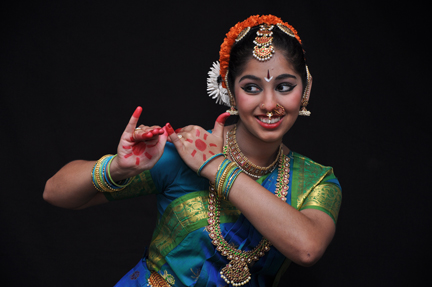Dashavataram

Dashavataram
Soorya Dance Company presents Dasha Avataram. In the ancient story books of Hinduism, there is a description of God Vishnu (“The Pervader”) taking different incarnations to maintain the order of life in the universe. Vishnu’s job is a Stithi Kartha (protector or maintainer) of the natural activities of the universe. Vishnu is often called “avatara purusha” (Incarnation person). The ten incarnations describe the different episodes of balancing acts of the natural order.
- Matysa Avatara: After a cycle of time, Lord Brahma ( creator) wishes to rest in his sleep. There will be a Jala Pralaya (apocalypse of water) at that time. Everything in the Universe will submerge before the Satya Yuga (the era of truthfulness). Lord Vishnu decides few pious people and objects need to continue the knowledge flow to the next era. He suggests that King Satyavrata (followers of Truth) build the ship. Vishnu himself assumes the form of Matysa (colossal fish) and navigates the wretched turbulence of cosmic oceans. While Brahma sleeps, his divine rule book – Veda will, is stolen by a horse-faced evil demon called Hayagriva. Matsya fights and kills him to restore the order of the universe.
- Koorma Avatara: Amrutha, the elixir of immortality, is lost in the deep Milky Ocean. Both demigods and demons churn the ocean milk using Mandara mountain, making the colossal serpent Vasuki as rope. While churning, the mountain starts sinking under the ocean. Everyone prays for help. Vishnu assumes the form of a tortoise and saves them by supporting the mountain from the bottom.
- Varaha Avatara: Varaha, the boar, from the Satya Yuga: He defeats Hiranyaksha, a demon who had taken the Earth, or Prithvi, and carried it to the bottom of the cosmic ocean. The battle between Varaha and Hiranyaksha lasted for a thousand years, which the former finally won. Varaha carried the Earth out of the ocean between his tusks and restored it to its place in the universe.
- Narasimha, the half-man/half-lion, from the Satya Yuga: The rakshasa (An evil person) Hiranyakashipu, the elder brother of Hiranyaksha, was granted a powerful boon from Brahma, not allowing him to be killed by man or animal, inside or out, day or night, on earth or the stars, with a weapon either living or inanimate. Vishnu descended as an anthropomorphic incarnation, with the body of a man and head and claws of a lion. He then disembowels the rakshasa at the courtyard threshold of his house, at dusk, with his claws, while he lay on his thighs.
- Vamana, the dwarf, from the Treta Yuga: The fourth descendant of Hiranyakashya, Bali, with devotion and penance was able to defeat Indra, the god of firmament. This humbled the other deities and extended his authority over the three worlds. The gods appealed to Vishnu for protection and he descended as the dwarf Vamana. During a yajna of the king, Vamana approached him and Bali promised him for whatever he asked. Vamana asked for three paces of land. Bali agreed, and the dwarf then changed his size to that of a giant. He stepped over heaven in his first stride, and the netherworld with the second. Bali realized that Vamana was Vishnu incarnate. In deference, the king offered his head as the third place for Vamana to place his foot. The avatar did so and thus granted Bali immortality. Then in appreciation to Bali and his grandfather Prahlada, Vamana made him ruler of Pathala, the netherworld.
- Parashurama, warrior with the axe, from the Treta Yuga: He is son of Jamadagni and Renuka and received an axe after a penance to Shiva. He is the first Brahmin-Kshatriya in Hinduism, or warrior-saint, with duties between a Brahmana and a Kshatriya). King Kartavirya Arjuna and his army visited the father of Parashurama at his ashram, and the saint was able to feed them with the divine cow Kamadhenu. The king demanded the animal, Jamadagni refused, and the king took it by force and destroyed the ashram. Parashurama then killed the king at his palace and destroyed his army. In revenge, the sons of Kartavirya killed Jamadagni. Parashurama took a vow to kill every Kshatriya on earth twenty-one times over, and filled five lakes with their blood. Ultimately, his grandfather, rishi Rucheeka, appeared and made him halt.
- Rama, the prince and king of Ayodhya, from the Treta Yuga: He is a commonly worshiped avatar in Hinduism and is considered the ideal heroic man. His story is recounted in one of the most widely-read scriptures of Hinduism, the Ramayana. While in exile from his kingdom with his brother Lakshman and the monkey God Hanuman, his wife Sita was abducted by the demon king of Lanka, Ravana. She was kept as a prisoner in Ashoka Vatika in Lanka. Rama took an army of supporters and killed the demon king, thus saving Sita.
- Krishna was the eighth son of Devaki and Vasudev from the Dwapara Yuga. Krishna was born as the son of Devaki and Vasudeva. He was moved to Gokula to save him from Kansa. Later, he kills Kansa and assists virtuous Pandavas in the great Mahabharatha war. He preaches “Geetha”, the highest philosophical work of Hinduism in the middle of a war to Arjuna.
- Buddha: Gautama Buddha, the founder of Buddhism, is generally included as an avatar of Vishnu in Hinduism. Buddha may be depicted in Hindu scriptures as a preacher who deludes and leads demons and heretics away from the path of the Vedic scriptures. Born as Prince Siddhartha, who was protected from worldly pain. He learns about life when he witnesses others’ old age, sickness, and death. Abdicates the throne and seeks knowledge for 12 years under a Banyan tree. He becomes Buddha and shares his knowledge to living a pious life.
- Kalki ("Eternity,” or "White Horse,” or "Destroyer of Filth") will be the final incarnation of Vishnu, foretold to appear at the end of Kali Yuga, our present epoch. He will be atop a white horse, and his sword will be drawn, blazing like a comet. He is the harbinger of the end time in Hindu eschatology and will destroy all unrighteousness and evil at the end of Kali Yuga.
Music Direction: Srivathsa
Choreography Guru Prasanna Kasthuri
Performers: Aditi Sriram, Akshaya Nalluri, Annapurna Pakrasi, Brinda Mudduluri, Dhruti Kondamadugula, Diya Arun, Harini Saravanan, Hritika Malugu, Ishita Sanghavi, Kaavya Panchal, Kirthi Ramesh, Meenakshi Kadungath, Mridini Nandakumar, Neha Patlu, Nidhisha Pejathaya, Saanvi Ramgounda, Sahasra Muddu, Sapthaka Upadhya, Shreenidhi Senthilnathan
Lighting: Vinu Sharma
Sound: Vikram Kini
Stage: Nagendra Boggarapu and Vinod Shenoy
